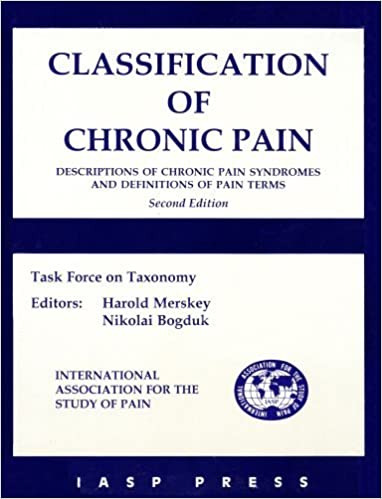| 1986年 | IASPは「Classification of chronic pain : descriptions of chronic pain syndromes and definitions of pain terms」 Subcommittee on Taxonomy ; editor, Harold Mersey [Pubmed]を発刊した。 |
| 1994年 |  IASPは「Classification of Chronic Pain:descriptions of chronic pain syndromes and definitions of pain terms, second edition」(Harold Mersey, Nikolai Bogduk)*を発刊した。 IASPは「Classification of Chronic Pain:descriptions of chronic pain syndromes and definitions of pain terms, second edition」(Harold Mersey, Nikolai Bogduk)*を発刊した。 |
| 2016年 | 2月16日 IASPのタスクフォース↓はWHOと協力して、鎮痛薬、プライマリケア、リソースの乏しい環境など、幅広いコンテキストに適用できる慢性疼痛の分類システムを開発した。 |
| 2017年 | IASPの用語委員会(委員長Eva Kosek)は慢性疼痛の第3の機構分類として、nociplastic painを採用した。 |
| 2019年 | 5月25日 ICD-11は承認された。* |
| 2020年 | IASPは41年ぶりに、痛みの定義を改訂した。 @terminology@history |
| 2022年 | 1月1日 ICD-11は発効される。「chronic pain」の新しい定義の導入され、新たな「chronic primary pain」の疾患分類が採用される。 |
International Classification of Diseases: ICD-11
←→1IASP-Chronic_Pain_Syndromes /2MG30 /3PAIN_Treede2015 /4PAIN_Nicholas,2019 /5IASP-ICD11 /6PPM /7WHO-ICD11
←→ガイドライン /牛田 /森脇 /研究班
(International Classification of Diseases Task Force (ICD-11)*
-
Co-Chair: Rolf-Detlef Treede, Winfried Rief, Germany
Coordination: Beatrice Korwisi
Consultants: Antonia Barke, Nadine Attal, Qasim Aziz, Michael I. Bennett, Rafael Benoliel, Milton L. Cohen, Stefan Evers, Nanna Finnerup, Stefan Friedrichsdorf, Maria Adele Giamberardino, Stein Kaasa, Eva Kosek, Patricia Lavond'homme, Michael Nicholas, Serge Perrot, Stephan Schug, Blair Smith, Peter Svensson, Johannes Vlaeyen, Lars Arendt-Nielsen)
Structure of the ICD-11 Classification →ICD-11 for Mortality and Morbidity Statistics
>Chapter 21 Symptoms, signs or clinical findings, not elsewhere classified
>General symptoms, signs or clinical findings >General symptoms
>Pain >MG30 Chronic pain(MG31 Acute pain、MG3Z Pain, unspecified)
| MG30 | Chronic pain | 慢性疼痛 | ||||
| Chronic pain is pain that persists or recurs for longer than 3 months. Chronic pain is multifactorial: biological, psychological and social factors contribute to the pain syndrome. Chronic pain has been recognized as pain that persists past normal healing time and hence lacks the acute warning function of physiological nociception. Usually pain is regarded as chronic when it lasts or recurs for more than 3 to 6 months. Chronic pain is a frequent condition, affecting an estimated 20% of people worldwide6, and accounting for 15% to 20% of physician visits. Chronic pain should receive greater attention as a global health priority because adequate pain treatment is a human right, and it is the duty of any health care system to provide it. @Treede 慢性疼痛は,正常な治癒時間を過ぎても持続する痛みとして認識されていて、生理的侵害受容の急性警告機能を欠いている。通常、痛みが3~6カ月以上続いたり再発したりする場合は、慢性とみなされる。慢性疼痛はよくみられる病態であり、世界中で推定20%の人々が罹患しており、医師の受診の15%~20%を占める。適切な疼痛治療を受けることは人権であり、それを提供することはあらゆる医療システムの義務であるため、世界的な健康優先事項としてより大きな注目を受けるべきである。 | ||||||
| 慢 性 一 次 性 疼 痛 | MG30.0 | Chronic primary pain:CPP↓ | 慢性一次性疼痛 | |||
| MG30.00 | Chronic primary visceral pain Inclusions Chronic primary chest pain syndrome Chronic primary epigastric pain syndrome Chronic primary bladder pain syndrome Chronic primary pelvic pain syndrome Chronic primary abdominal pain syndrome | 慢性一次性内臓痛 | ||||
| EC92.0 | Mucocutaneous or cutaneous pain syndromes(Penoscrotodynia) | 粘膜皮膚痛症候群 | ||||
| GA34 | Pain related to vulva, vagina or pelvic floor(Vulvodynia) | 外陰、腟、または骨盤底に関連する疼痛 | ||||
| DD91.0 | Irritable bowel syndrome | 過敏性腸症候群 | ||||
| DD91.00 | Irritable bowel syndrome, constipation predominant | 過敏性腸症候群便秘型 | ||||
| DD91.01 | Irritable bowel syndrome, diarrhoea predominant | 過敏性腸症候群下痢型 | ||||
| DD91.02 | Irritable bowel syndrome, mixed type | 過敏性腸症候群混合型 | ||||
| DD91.03 | IIrritable bowel syndrome, unsubtyped | |||||
| DD91.0Z | Irritable bowel syndrome, type unspecified | 過敏性腸症候群便秘型、詳細不明 | ||||
| DD94 | Functional gallbladder disorder | 機能性胆嚢障害 | ||||
| DD95 | Functional sphincter of Oddi disorder | |||||
| MG30.01 | Chronic widespread pain | 慢性広汎性疼痛 | ||||
| MG30.01a | Fibromyalgia | 線維筋痛症 | ||||
| MG30.01y | Other chronic widespread pain | その他の慢性一次性疼痛 | ||||
| MG30.01Z | Chronic widespread pain,unspecified | 慢性一次性疼痛、詳細不明 | ||||
| MG30.02 | Chronic primary musculoskeletal pain Inclusions Chronic primary low back pain Chronic primary cervical pain Chronic primary thoracic pain Chronic primary limb pain | 慢性一次性筋骨格系疼痛 | ||||
| MG30.03 | Chronic primary headache or orofacial pain | 慢性一次性頭痛または口腔顔面痛 | ||||
| 8A80.2 | Chronic migraine | 慢性片頭痛 | ||||
| 8A81.2 | Chronic tension-type headache | 慢性緊張性頭痛 | ||||
| 8A82 | Trigeminal autonomic cephalalgias (TACs) | 三叉神経・自律神経性頭痛 | ||||
| DA0F.0 | Burning mouth syndrome | 口腔内灼熱症候群 | ||||
| 8D8A.0 | Complex regional pain syndrome | 複合性局所疼痛症候群 | ||||
| 8D8A.00 | Complex regional pain syndrome type I | 複合性局所疼痛症候群 type I | ||||
| 8D8A.01 | Complex regional pain syndrome type II | 複合性局所疼痛症候群 type II | ||||
| 8D8A.0Y | Other specified complex regional pain syndrome | その他の明示された複合性局所疼痛症候群 | ||||
| 8D8A.0Z | Complex regional pain syndrome, unspecified | 複合性局所疼痛症候群、詳細不明 | ||||
| ED02 | Painful bruising syndrome | 有痛性挫傷症候群 | ||||
| MG30.0Y | Other specified chronic primary pain | その他の明示された慢性一次性疼痛 | ||||
| MG30.0Z | Chronic primary pain, unspecified | 慢性の一次性疼痛、詳細不明 | ||||
| 慢 性 二 次 性 疼 痛 | MG30.1 | Chronic cancer related pain | 慢性がん関連疼痛 | |||
| MG30.2 | Chronic postsurgical or post traumatic pain | 慢性術後/外傷後疼痛 | ||||
| MG30.3 | Chronic secondary musculoskeletal pain | 慢性二次性筋骨格疼痛 | ||||
| MG30.4 | Chronic secondary visceral pain | 慢性二次性内臓痛 | ||||
| MG30.5 | Chronic neuropathic pain | 慢性神経障害性疼痛 | ||||
| MG30.6 | Chronic secondary headache or orofacial pain | 慢性の二次性頭痛/口腔顔面痛 | ||||
*日本医学会や厚生労働省*の訳
Y Other specified・・・ : その他の明示された・・・
Z unspecified: 詳細不明
MG30.0 Chronic primary pain:CPP 慢性一次性疼痛 参考MG30.0/3PAIN_Nicholas,2019
|